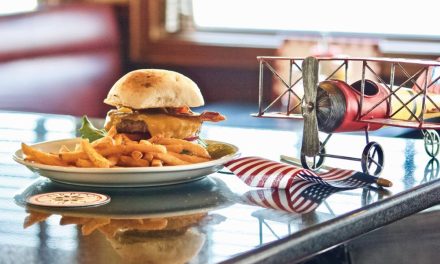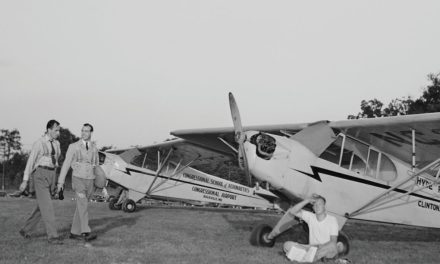By Joel Turpin, ATP/CFII/FAA Master Pilot
There are two types of authority bestowed by the FAA on the pilot in command (PIC) of every airplane, regardless of its size. They are:
- Pilot in command authority
- Pilot in command emergency authority
In this tutorial, we will explore both kinds, with an emphasis on how and when to use each type. Keep in mind that the boundary between the two can be blurred at times. We will also discuss the limits of what the PIC is authorized to do when exercising each type of authority.
An overall distinction between the two types of authority is that PIC authority is generally used to prevent an unsafe situation, while PIC emergency authority is used to escape from one. But again, this distinction is not intended to be considered as fact.
PILOT IN COMMAND AUTHORITY
It is imperative that we begin the discussion with a review of what the FARs say about pilot in command authority. FAR 91.3(a) states: “The pilot in command of an aircraft is directly responsible for, and is the final authority as to, the operation of that aircraft.”
What the FAA is saying is that the PIC should not allow outside influences to lead him or her into an unsafe situation. Preventing this from happening is where your PIC authority comes into play, and it can best be illustrated by using examples.
The Proper Use of PIC Authority
As mentioned earlier, PIC authority is normally used to prevent an encounter with an unsafe situation. Let’s say you are on an IFR flight and cruising above clouds in which icing conditions exist. ATC says that, due to traffic ahead, you are cleared to descend to an altitude that will put you in icing conditions, for which your airplane is not equipped. Since you are the final authority as to the operation of your airplane, you should exercise your PIC authority by telling the controller that you are unable to accept the clearance.
In this case, the outside influence is the controller who could not see the situation as you saw it, and may not have known that the clearance he issued would put you in icing conditions. This is the reason the FAA makes the pilot in command the ultimate authority as to the operation of his or her airplane.
Many years ago, I found myself in a situation that was the very essence of using pilot in command authority to prevent an emergency. I had flown from St. Louis to Springfield, Missouri, in a Piper Arrow on a night IFR flight under FAR Part 135. After successfully negotiating a line of tornado-bearing severe thunderstorms enroute, I arrived in Springfield to find that the entire city had been darkened by a major power outage due to storm damage. More importantly, the Municipal Airport, my destination, was closed because the airport was without lights.
It appeared as though I would have to divert. But where could I go with an hour of fuel and be assured that the diver sion airport would have lights? If I diverted and found that I could not land, I would be low on fuel with no place to go.
While circling over the eastern side of the city, I discovered that, in spite of the darkness, I had sufficient visual cues to clearly identify a small, uncontrolled field below me, even though the runway boundary lights were not working. A landing there would be easy and safe, but it would not be legal since I was operating under FAR Part 135 and the regulations said that runway boundary lights were required for night landings.
After pondering my options, I elected to use my pilot in command authority and landed safely at the uncontrolled field without runway lights, even though it violated FAR Part 135. In this incident, I had a choice between staying legal and possibly running out of fuel at night, or bending the rules and landing safely. I chose safety over legality knowing I could easily justify using my PIC authority if confronted by the FAA.
Another example of how “The pilot in command of an aircraft is directly responsible for, and is the final authority as to, the operation of that aircraft” is illustrated in the following incident that happened to me while flying a Boeing 757. The size of the airplane is not relevant, so please concentrate on the situation and how it was handled, and not the type of airplane involved. This incident is another illustration on how to use your PIC authority to prevent an emergency from developing.
My flight plan called for an arrival at New York’s La Guardia airport at 11:00 p.m. with nearly two hours of reserve fuel. The extra fuel was boarded for anticipated delays due to thunderstorms not only at our departure station, but enroute as well. There was a curfew in effect for KLGA that closed the airport at 1:00 a.m. so that maintenance, such as painting stripes and changing light bulbs, could be accomplished.
As the result of an incredible chain of events, including extensive ground delays, reroutes, and holding patterns, I arrived on final approach to Runway 22 seven miles from touchdown and four minutes prior to the 1 a.m. curfew with just 40 minutes of fuel remaining. But those 40 minutes were calculated in level flight, and a full-power go-around (with flaps and gear down) would consume 20 minutes of it, leaving us with just 20 minutes of fuel to divert to KJFK, our alternate. Even though we were not presently critically low on fuel, a go-around would put us in an emergency situation.
With this in mind, I briefed my first officer that if they closed the airport before our arrival and instructed us to go around, we would declare an emergency and land anyway. Fortunately, we landed before curfew, but during rollout, the LGA tower controller announced that the airport was closed and instructed the MD-80 on final approach behind us to go around.
This is another example of using PIC emergency authority to prevent an emergency from developing. It is also an example of the pilot in command not letting outside forces influence the safety of the flight. While regimentation is a good thing, the PIC must remain flexible enough to think out of the box when unusual circumstances arise that could compromise safety.
Use Your PIC Authority Responsibly!
While the FARs give the PIC wide discretion on the operation of his or her airplane, it is an authority not to be abused. Here is an example of how not to use it.
We have just successfully completed a cross-country flight to our destination, an uncontrolled field, with over two hours of fuel remaining. Upon arrival, we find that the crosswind is out of limits for a safe landing. However, this airport has a closed runway that is perfectly aligned with the wind. Can we use our pilot in command authority and land on the closed runway?
The answer is an emphatic no! With more than two hours of fuel remaining, we have the option of diverting to another airport with more favorable winds. In this example, safety is not an issue, which precludes the use of PIC authority. In short, you cannot use PIC authority for convenience.
Now let’s change the scenario and arrive with insufficient fuel for a safe divert. This changes the situation altogether, and exercising our PIC authority and landing on the closed runway would be an option. Naturally, the FAA might want to know why you arrived so low on fuel, and whether or not you checked the forecast before departure, but this is beyond the scope of our discussion. In any case, the first priority is to land safely and deal with the consequences later.
PILOT IN COMMAND EMERGENCY AUTHORITY
FAR 91.3(b) addresses PIC emergency authority by stating;
“In an inflight emergency requiring immediate action, the pilot in command may deviate from any rule of this part to the extent required to meet that emergency.”
As mentioned in the introduction, emergency authority is normally used to extract oneself from an immediate threat to the safety of the flight. But it can also be used as a tool to prevent an emergency. However, before we use this authority in either manner, we must first declare an emergency. Once declared, all FARs, AIM procedures, and even those procedures and limitations in the airplane flight manual, may be disregarded – but only to the extent necessary to mitigate the situation.
While this is plainly stated in FAR 91.3(b), many pilots are so inculcated with doing the “right” thing that when it comes time to deviate from the norms of flight, they are unable to do so. As a result, there is no shortage of accidents caused by pilots who were too regimented to think creatively during a dire, life-threatening emergency. The next few paragraphs will illustrate what happens when pilots make staying legal a priority during a critical situation.
Pilots Truly in Command
As pilots, we are a conservative bunch by nature, and are loathe to venture outside the norms of our vocation. From our very first flying lesson, we have been taught to never violate the FARs, the procedures set forth in the AIM, or the procedures and limitations in airplane flight manuals.
Instrument pilots are drilled to make an immediate go-around if the runway is not in sight at the missed approach point, and that descending below minimums during an approach is tantamount to blasphemy.
And then there are those norms and conventions that are harder to define, but nonetheless a part of flying. For example, you must comply promptly with all clearances issued by air traffic control, or you must enter the traffic pattern in a prescribed manner.
On the other hand, what is rarely taught is this; there is a time when deviating from the norm is not only required, but imperative to prevent a disaster.
For example, in a dire emergency, it is okay to violate the FARs if that action is necessary to prevent an accident. Many pilots forget that once an emergency is declared, all FARs are null and void, as are instrument approach minimums, AIM procedures, Standard Operating Procedures, and flight manual limitations.
Addendum: A Note to Instrument Instructors
Pilots should always be alert for those rare and unusual situations where deviating from the norm is required. Good pilots maintain flexibility in their thinking and are able to innovate when things go wrong in flight. Instrument instructors can expose their students to this kind of thinking through scenario-based training.
Try giving your students simulated problems while flying an approach under the hood or foggles. Some scenarios might include a failed alternator, oil pressure on zero, ice accumulating on the wings, etc. Then, at the missed approach point, tell them the runway is not in sight. This will make the student choose between continuing below minimums to a safe landing, or going around with the ensuing consequences.
It is a good way to emphasize to your student that there is a time to obey the rules, and a time to deviate, with safety and common sense being the arbiter of their decision.
As stated in FAR 91.3(b), during a declared emergency, the pilot in command is free to take any action necessary to save his airplane and passengers from an accident. Even so, pilots have died during an emergency while trying to comply with the FARs or SOP, when another course of action would have been their salvation.
When Not to Obey Standard Operating Procedures
One of the most egregious examples of clinging to SOP and flight manual limitations when a deviation was clearly indicated involved Swiss Air Flight 111. The big MD-11 had departed New York and was eastbound on a trans-Atlantic flight to Switzerland. About an hour into the flight, an electrical fire developed in the cockpit overhead circuit breaker panel, located just above and behind the pilots. The fire created a great deal of smoke throughout the airplane.
Since they had just taken off, the MD-11 was well above the maximum landing weight listed in the airplane flight manual. In the case of an engine failure or other less threatening emergency, the flight crew would normally dump fuel down to landing weight to prevent undue stress on the landing gear. However, the airplane was on fire and the fire was growing rapidly.
The captain announced to the first officer that they were going to circle while dumping fuel down to landing weight. The first officer strongly disagreed and advocated an immediate overweight landing, but the captain overruled him and reiterated that they were too heavy to land and that they would dump fuel.
While in the process of dumping fuel, the fire caused structural failure and the MD-11 plunged into the Atlantic Ocean. The captain had dutifully complied with flight manual limitations and Standard Operating Procedures during an emergency … and took 229 people to their deaths.
Then there was the crash of an Air Florida Boeing 737 into the Potomac River after departing from Washington National Airport in a snow storm. This is another example of pilots being too regimented to deviate from the conventions of flight, even though it was clearly imperative to do so.
In this accident, the crew forgot to turn on the engine anti-ice during taxi out, even though it was snowing heavily. The gauges in the cockpit that indicate engine power had small pitot tubes in the engine intakes that fed information to the gauges. They were normally heated, but with the engine anti-ice system turned off, ice formed in these pitot tubes. On takeoff, the engine gauges gave the pilots erroneous readings, showing full power when in fact the engines were only putting out about 60 percent power.
The 737 struggled to lift off and climbed slowly to about 100 feet. However, with such a low power setting and with snow adhering to the airframe, it could not sustain flight and began descending. Both pilots watched as the airplane rapidly lost altitude. A crash was imminent.
The throttle levers were only about halfway towards being full forward, but neither pilot grabbed the throttles and rammed them as far forward as possible. Why? Because they were taught that it is harmful to the engines to shove the throttles full forward. It was one of those norms of flight that pilots should never violate and, ultimately, they died while trying to save their engines from an over boost. Again, neither pilot could deviate from normal conventions of flight, even when they were about to die.
In another incident, a King Air pilot found himself in a situation that was the very definition of a nightmare aloft. He was flying a King Air 90 on a medical life flight mission with a patient and flight nurse as passengers. While enroute over the Rocky Mountains, at night, in moderate icing conditions, he experienced an engine failure. He dutifully declared an emergency and proceeded to a high-altitude, mountain airport that only had a VOR approach.
With ice on the airframe and an engine shut down, he began descending to the Minimum Descent Altitude. Upon reaching the missed approach point, he found himself still in the clouds. The King Air pilot did what he had always been told to do, and that was to initiate an immediate missed approach. Naturally, his airplane would not climb on one engine, at high altitude, with a load of ice. The outcome was inevitable; he impacted a mountain during the attempted go-around and all aboard were killed. The thought of descending below minimums and possibly saving his life and those of his passengers was trumped by his fear of getting an FAA violation. He never considered that in an emergency, there are no such things as minimums.
One final example of a pilot being too regimented to deviate from the rules when it was clearly imperative to do so, involved an A36 Bonanza. With his fuel gauges on empty, the pilot began an ILS approach in low IFR weather. Upon reaching the decision altitude, the runway was not in sight and a missed approach was initiated. During climb out, the engine quit due to fuel starvation resulting in a fatal accident. Once again, the pilot never considered descending below minimums and landing safely as an option due to his fear of getting an FAA violation.
Conclusion
In difficult circumstances aloft, how does the pilot in command know when it is imperative to deviate from the regulations, the AIM, or other conventions of flight?
The litmus test is this: If you deviate, could you stand before an FAA inspector and honestly justify your actions? Was your situation dire enough to warrant the descending below minimums, violating the FARs, or not complying with SOP or other procedures?
In an emergency, the pilot in command must know intuitively when to do it “by the book” and when to “dance.”






